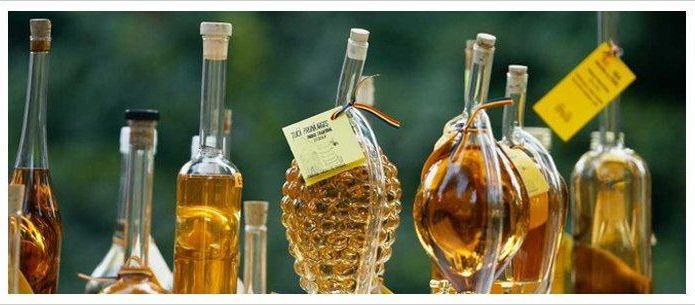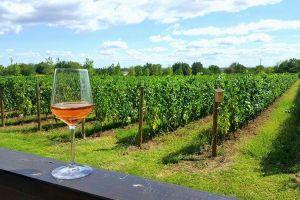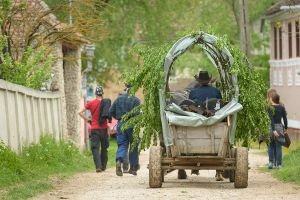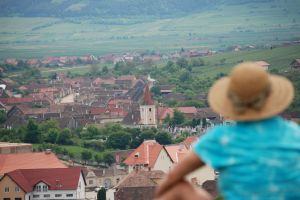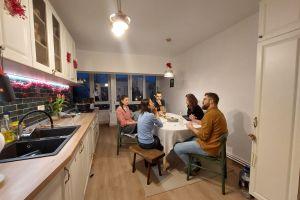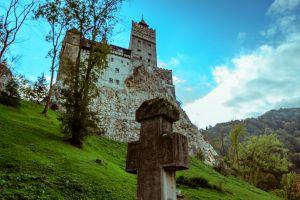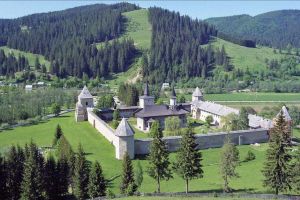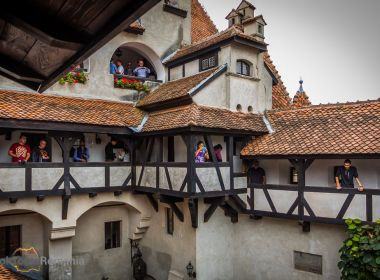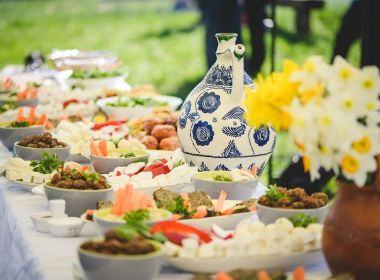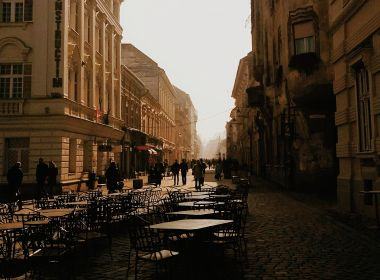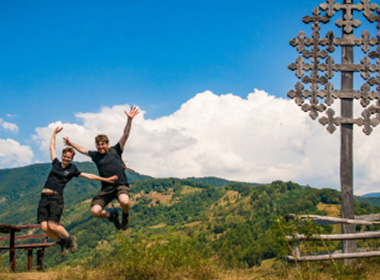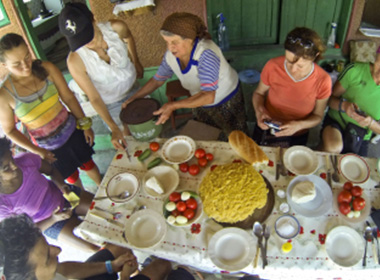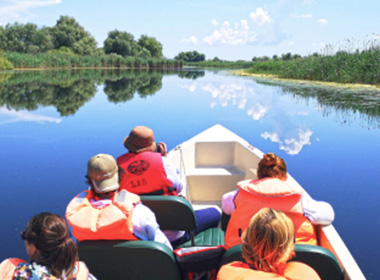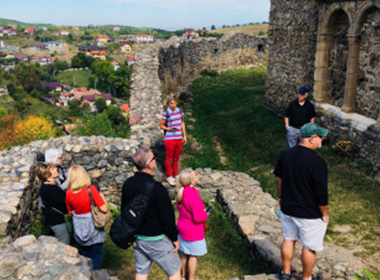If you're planning to visit Romania for the first time you’re probably wondering what are the best Romanian souvenirs that will remind you of the things you saw and experienced in our beautiful country.
Or maybe you want to buy a thoughtful gift for a friend or family members, something to surprise them on a special occasion?
Be warned - you’ll find plenty of cheap Dracula fridge magnets and tacky products made in China that have nothing to do with our country.
So if you're looking for authentic Romanian souvenirs, something truly representative and a tangible connection to our country's rich culture and heritage - then keep reading this article.
Looking at my “travel shelf” with souvenirs from all over the world, I know what it’s like to want to buy something unique and authentic when you visit a new place. So, as a local, it’s my mission to help you do this in Romania. Let’s get started!
Table of contents
- 1. Wooden items and cookware
- 2. The Romanian traditional blouse: Ie
- 3. Traditional Veils and Opinci (Traditional Shoes)
- 4. Clothing made of wool
- 5. Plum brandy (țuică or palincă)
- 6. A bottle of Romanian wine
- 7. Romanian honey and speciality products
- 8. Romanian jams
- 9. Bead jewellery
- 10. Romanian folk masks
- 11. Traditional pottery items
- 12. Glass-painted icons
- 13. Romanian cosmetics, skincare and naturopathy products
- 14. Dracula souvenirs
- 15. Hand-painted easter eggs
- 16. Mărțișoare (Spring trinkets)
- 17. Small musical instruments
1. Wooden items and cookware
Romania's rich woodlands and plentiful wood supply have long fueled the tradition of wood carving among local artisans. Among all traditional crafts, this one extends beyond mere artistic expression because historically it was used to create practical household tools, cookware, furniture pieces and many ornamental items.
Most hand-carved wooden items are great in the kitchen though. From intricately carved wooden spoons to spatulas, forks, cutting boards, rolling pins, meat tenderizers, plates, bowls, and more.
These wooden items are handmade and crafted with meticulous attention to detail and are usually adorned with folk motifs. They’re sturdy too and unlike plastic cookware - won’t leave traces of microplastics in your food!
You can find all sorts of wooden products all over Romania, but the traditional region of Maramures in North Western Romania, sometimes called land of wood epitomises this tradition with its amazing wood carvings artisans.
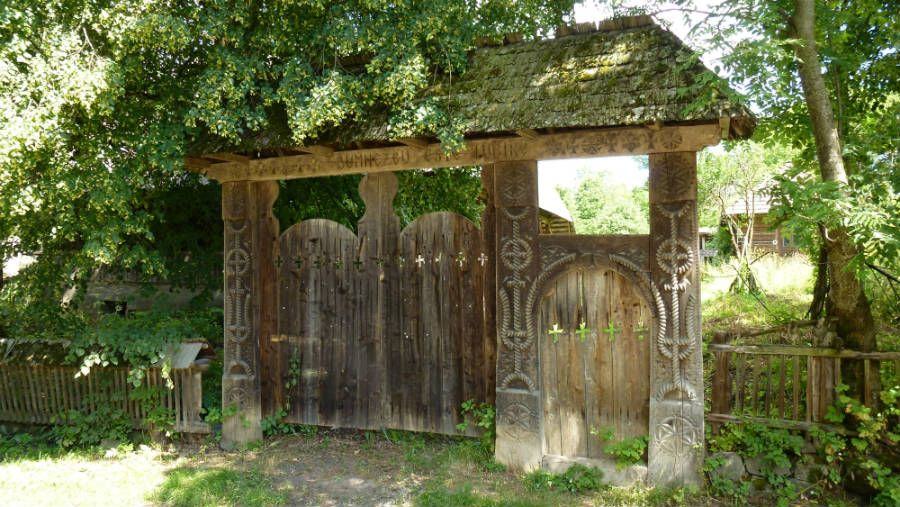
An intricately carved wooden gate is a status symbol in Maramures
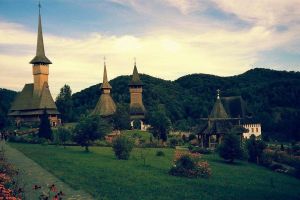
2 or 3 Days in Maramures: Wooden Churches, Traditions & Village Life
Start from: Cluj-Napoca
Visiting a woodcarver's workshop here offers an unforgettable glimpse into the artisan's craft and how these wooden products are made.
- Fun fact: In the neighboring Bucovina region you can visit a Wood Art Museum and even a small (and privately owned) wooden spoons museum!
- Where to buy
The best place to find authentic wooden souvenirs will be in rural areas as you may see stalls or small shops by the side of the road with them on display.
You may also find various wooden items at traditional fairs, village museums and even farmers' markets. Some souvenir shops have them too, but they’re probably mass-produced, not handmade, so be extra careful if you want the real deal.
2. The Romanian traditional blouse: Ie
Ie [pronounced y-e] is the name of the Romanian traditional blouse. It has a long history and is also known as the Carpathian shirt. Nowadays it is worn at special occasions and folk celebrations.
The traditional Romanian blouse is typically made of light, see-through fabric, a white cotton cloth perfect for summer days. It features a very rich decor code with intricate embroideries of geometric patterns on the sleeves, shoulders, and the front part of the blouse.
Each folk blouse is a narrative in itself reflecting the unique culture and heritage of the Romanian region it hails from. This diversity results in a myriad of variations of the ie.
What makes these folk blouses particularly special is that they are handmade through a labor-intensive process that requires a significant amount of time and skill. Crafted by skilled artisans, often elderly women from different parts of Romania, each blouse is a testament to their craftsmanship and dedication.
Local insight:If you go into Maramures on a Sunday you'll see locals dress up in traditional costumes to go to church
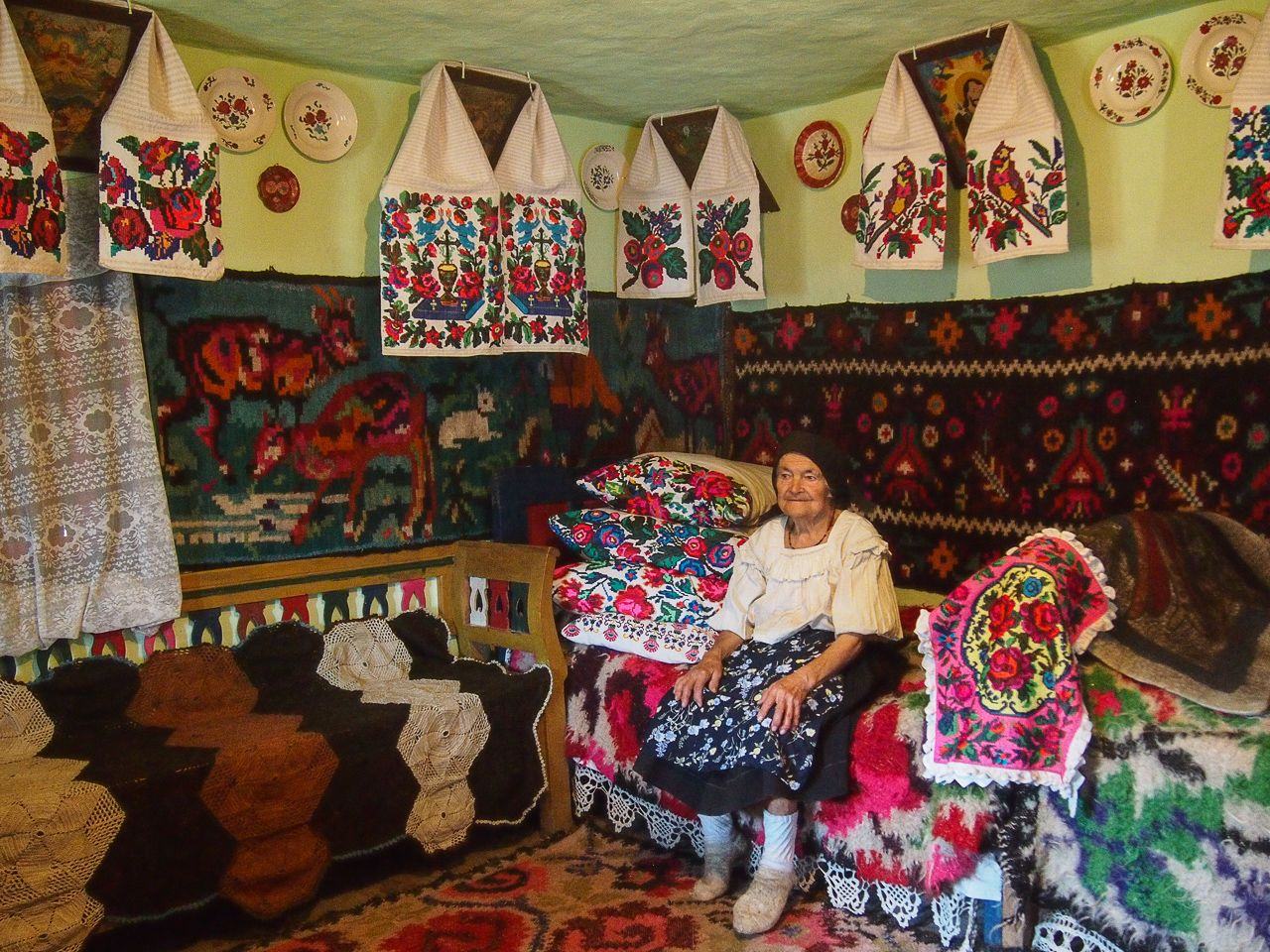
Each Romanian blouse is unique
That's why this is the most expensive and original Romanian souvenir you can find. Prices often start from 75 Euro or more, depending on how detailed the motive is, and delivery times can take around 6 months - unless you find one ready-made.
If you fancy wearing traditional clothes, then the ie is one of the best Romanian souvenirs you can take home. It’s stylish (famous fashion designers such as Yves Saint Laurent, Tom Ford or Carolina Herrera have used the Romanian traditional blouse as inspiration in their creations) and you can actually wear it - not just own it and look at it on a shelf.
And if you’re going for the full traditional Romanian outfit, you can also buy opinci (old traditional leather footwear) and a traditional veil (for women) or a traditional straw hat called "clop" (for men).
- Where to buy
You can find these traditional blouses in certain Romanian-owned clothing stores, at traditional fairs or at Christmas markets. There are some high-quality online shops too.
Watch out though, not all of them are original and many souvenir shops are flooded with cheap, low-quality versions of ie. You can ask where they are from and look for a tag or some sort of proof from the artisan, usually a small signature.
In recent years some local brands have taken a modern view and you can find regular cotton clothing with traditional Romanian motifs on them.
At traditional fairs you'll find the best Romanian souvenirs, check it out
3. Traditional Veils and Opinci (Traditional Shoes)
In the realm of Romanian traditional costume, two items stand out for their unique craftsmanship and cultural significance: the traditional veils, and the traditional peasant sandals, or opinci.
The design of the opinci is believed to date back to ancient times, allowing you to bring home a piece of a centuries-old tradition. As for the traditional veils, Romanian women once wore them to cover their heads, with each veil signifying a particular social status.
- Where to buy
Typically, you can find opinci and traditional veils for sale in rural areas and at traditional fairs.
4. Clothing made of wool
In Romania, traditional wool and wool-knitted clothing hold a special place in our culture, especially during the cold winters that can linger until late April, particularly in mountainous regions.
Many of us have fond memories of our mothers or grandmothers knitting wool pullovers, jackets, socks, slippers, vests, hats, scarves, and so on. These items are not only practical, keeping us warm during chilly winters, but they also carry a timeless appeal that transcends fashion trends.
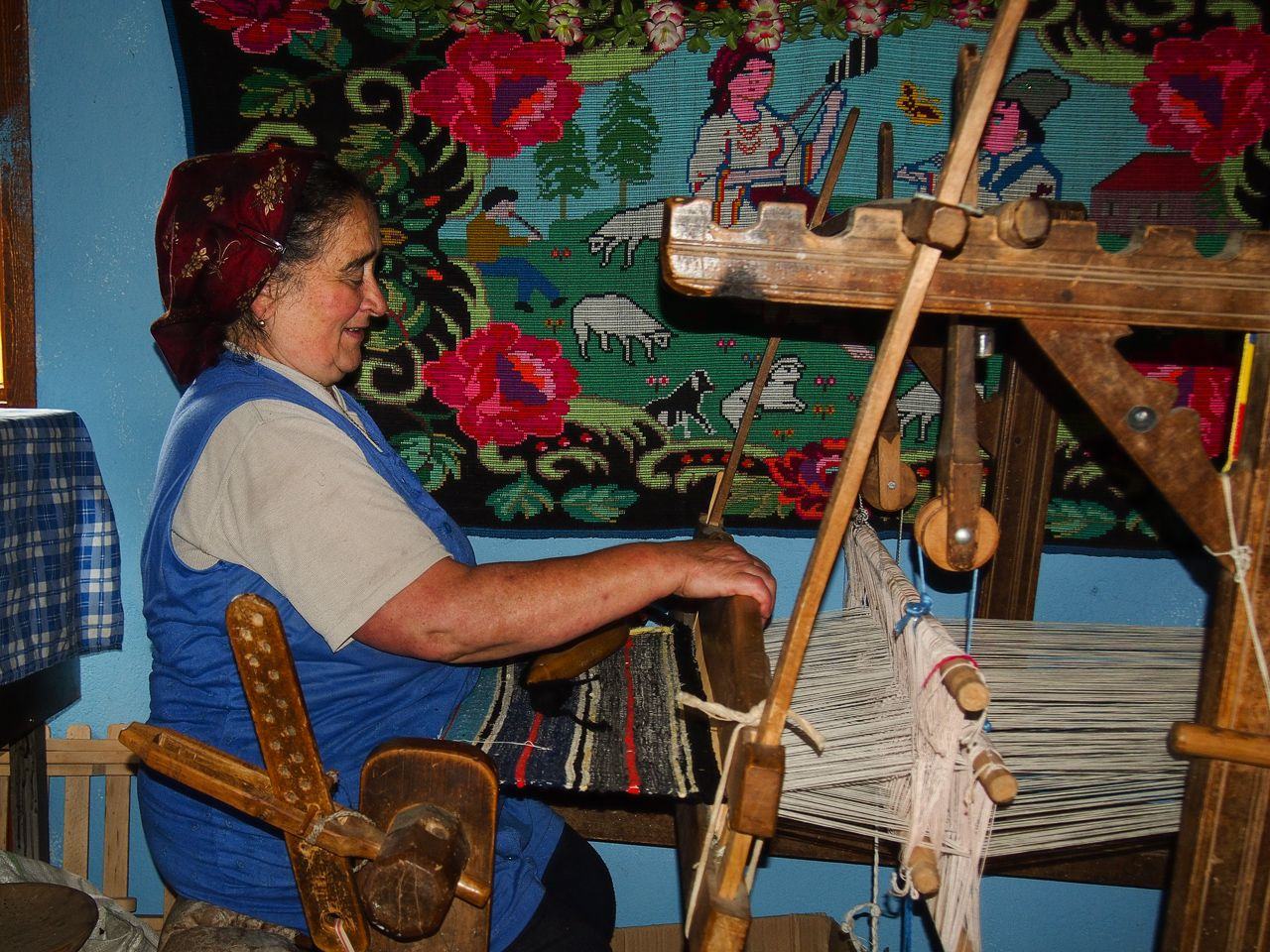
Observing these ladies knit using traditional techniques at a machine called razboi while surrounded by their creations, is a glimpse into a tradition that has been passed down through generations.
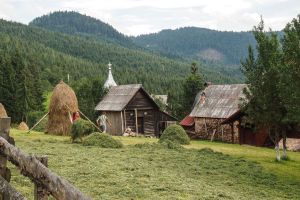
2 Day Hiking in Apuseni Natural Park: Culture & Local Life
Start from: Cluj-Napoca or Sibiu
Just FYI, Romanians also have an old tradition of making traditional rugs made of wool, but I figure a handmade rug might be a little too big to take as a souvenir :)
- Where to buy
While traditional wool clothing may not be readily available in mainstream stores, it's worth exploring rural areas to find the traditional ones that embody the warmth and craftsmanship of Romanian heritage.
Woolen products, often handmade, are commonly found in the countryside, where skilled artisans, usually elderly women, proudly display their craft at small stands.
The region of Bucovina is particularly known for these products since it's colder than most in the country.
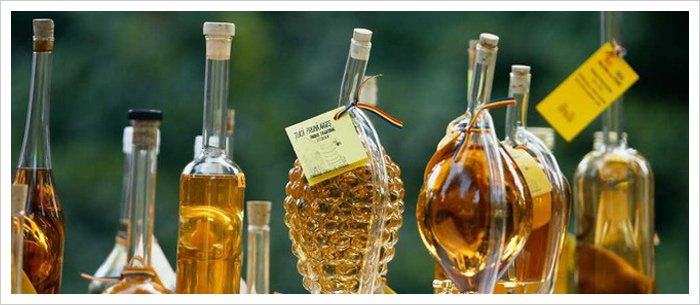
5. Plum brandy (țuică or palincă)
In Romania, making your own alcohol is virtually a national right and everyone does it. Go into any local's home and this is the first thing they'll serve you :)
Almost all Romanian traditional strong drinks are made by fermenting and distilling fruit, which technically makes them a “brandy”.
Among these brandies, țuică and palincă are national Romanian drinks - very strong too!
The very best țuică is made with nothing but plums and yeast and has no sugar added. If you swap plums with pears, you get _rachiu_. It usually comes out crystal clear, looking identical to water. Țuică usually contains 40–55% alcohol by volume, so when it hits the stomach you can truly feel its gut-warming power.
The other one, palincă - also called horincă or jinars depending on the region where it's made - is simply a term people use to refer to the previous țuică that’s been distilled a second (or third) time, thus meaning it’s much stronger and has more alcohol per volume (up to 86%).
Alternatively, if you prefer a sweet, fruit-flavored liqueur, look for vișinată (made with sour cherries), afinată (made with blueberries) or caisată (made with apricots).
Vișinată is my favorite and also the easiest to find, including in some restaurants. The other liqueur varieties might require some searching, as they're not produced in big quantities.
- Where to buy
You will find these alcoholic drinks in many souvenir shops and even in supermarkets, but we recommend buying them in rural areas while visiting locals, where the quality is 'tested' and you might even meet the people who made them :)
Transylvania is the most renowned region for producing good quality palinca and that's where you'll most commonly find this great Romanian souvenir.
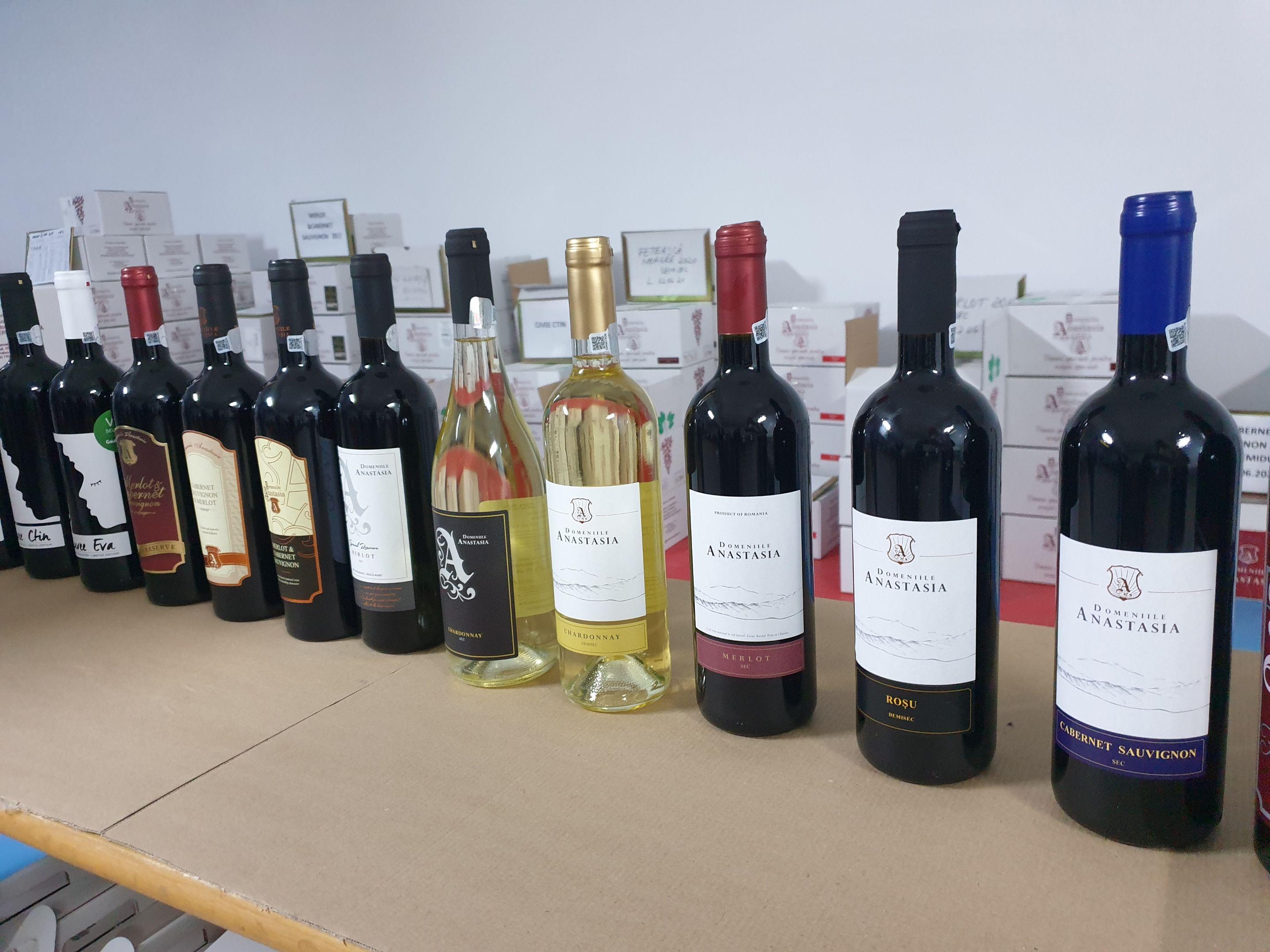
6. A bottle of Romanian wine
Did you know Romania has one of the oldest wine-making traditions in Europe (approx. 2,000 years old), and some assortments of wines are found nowhere else?
Our plains and hills provide optimal conditions for vine cultivation, which is why it is home to numerous vineyards - and wine-tasting opportunities.
And in the past 15-20 years, winemaking has been resurrected by a new generation of producers who go for quality and small quantities. So now you can taste some very good high-quality wines comparable to those in France and Italy - but cheaper :)
Famous local wines and varieties we recommend you explore:
- for white wines local varieties include: Busuioaca de Bohotin, Fetească Albă, Grasă de Cotnari, and Tămâioasă Românească. As for bottles, go for Solo Quinta Recaș, Alira, Prince Stirbey Crâmpoșie, Liliac or Serve wineries
- the local red wine variety is Fetească Neagră and bottles - there are many - but among the best are: 1000 De Chipuri Fetească Neagră, Roșu de Vaselo of Petro Vaselo, Karakter and 3 Fete Negre of Aurelia Visinescu
Most wineries are concentrated in the Dealu Mare region 1,5h away from Bucharest. This is the best and most fertile for vines so you'll find premium wine producers as well as artisans. Several wineries are also in the region of Transylvania though more sparse.
We enjoy including wine tastings in our tours, as Romania is an excellent destination for wine tourism, with many wine cellars and vineyards to visit. If you’re interested in this, let us know! :)
- Where to buy
You can buy Romanian wines in almost all shops and supermarkets. The bigger the shop, the larger the variety. Drink shops and wine shops are also good places to ask for recommendations or best sellers.
For a different experience, you can also check out traditional fairs where local producers show their skills. In some parts of the country, there are small vineyards too.
Local insight:beware of Dracula wines which you’ll find in duty-free shops of Romanian airports - but nowhere else! While they may look nice - they’re of low quality so you’ll pay a lot of money for a good-looking bottle.
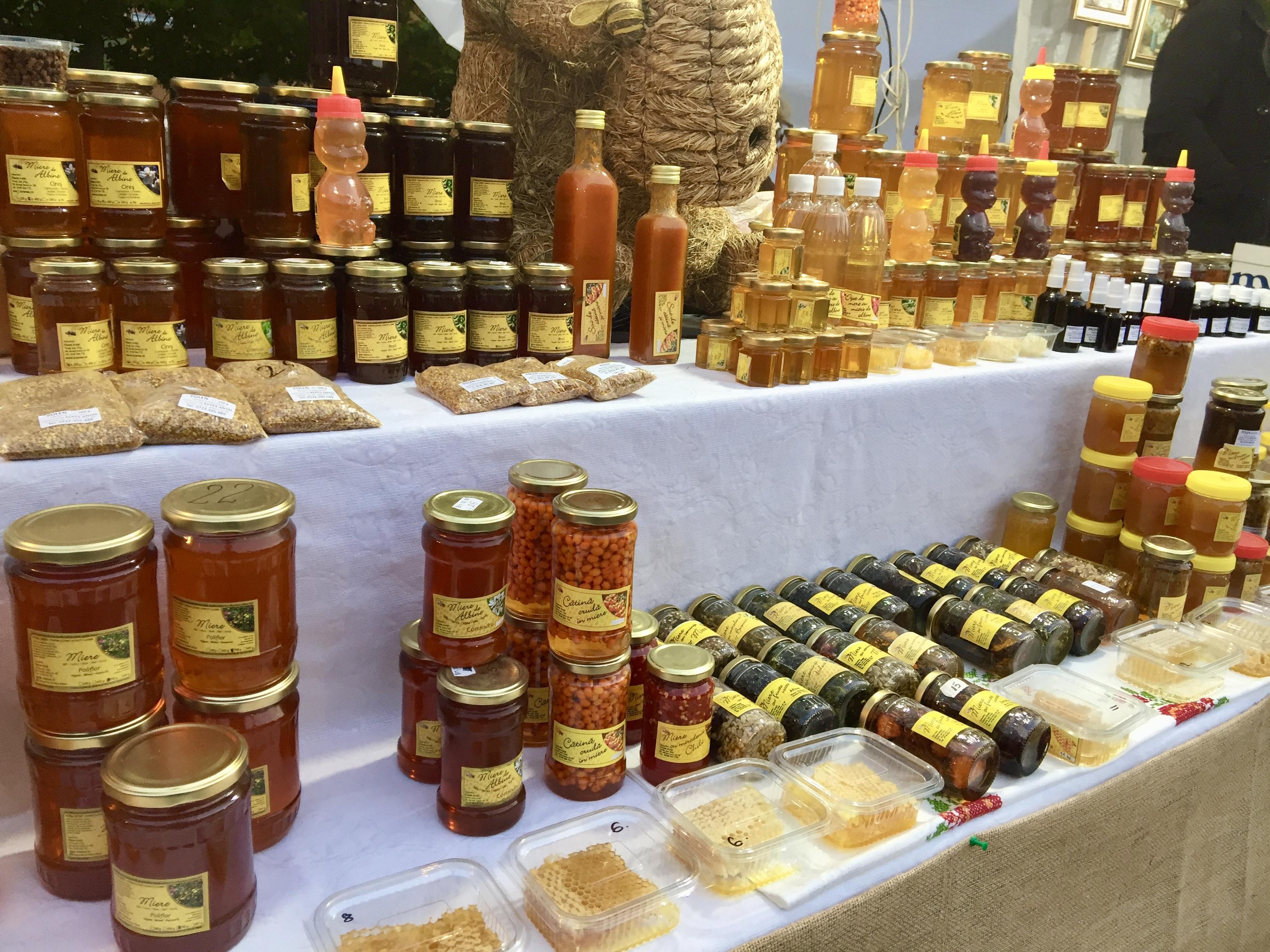
7. Romanian honey and speciality products
Another long tradition in our country is that of honey-making and derivative products.
And thanks to our diverse geography with many areas untouched and wild, there are lots of blooming wildflowers and trees to keep honey bees very busy all year round. In fact, the Romanian mountains are known for their rich wilderness and rich biodiversity and some Romanian national parks are real-life zoos and botanical gardens.
This results in high-quality honey made by small local producers in remote villages often close to the mountains. Common honey varieties are acacia, linden, rape, sunflower, and poly-floral (my favorite).
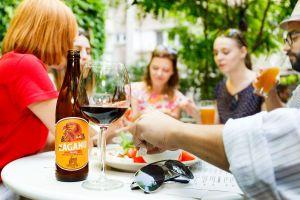
Bucharest Street Food Tour: Farmers' Markets & Hidden Streets
Start from: University Square
So while it might seem like a common commodity, a jar of honey is one of the best Romanian souvenirs you can buy. It will be a healthy reminder of our country every time you sweeten your morning tea - or enjoy it on a slice of bread (my favorite). It can also be a great gift for friends and family, including for children since it's a much better alternative to sugar.
Local tip:You can also opt for other bee products, such as propolis, pollen, or beeswax, all very appreciated by locals and often consumed for health and medicinal purposes.
- Where to buy
You can buy Romanian honey in traditional markets, in shops specialized in natural products (commonly named Plafar by the locals), in some monasteries, and even when passing through villages in the country – they are placed at people's front gates for sale.
8. Romanian jams
Romania’s countryside is dotted with orchards, and even at the foothills of the mountains, apple trees thrive. During summer months, local markets burst with an abundance of fruits, which locals quickly turn into homemade fruit jams.
The tradition of making homemade jams is often led by family matriarchs, who take pride in crafting these delicacies. Unlike commercially produced varieties, homemade jams are cherished for their quality and the warm hospitality they represent in any Romanian family.
The most common flavors include quince, apricot, strawberry and cherry but more unique or delicacy offerings include fruit jams made out of rose petals, sour cherries, red berries, green walnut jam, and even onion and chilli peppers.
- Where to buy
The best places to buy Romanian jams are local food markets where peasants sell their products. You'll also find them in supermarkets, look for Raureni, Topoloveni or Camara Noastra brands.

Cluj-Napoca Food Tour: Food Markets, Regional Dishes and Coffee Culture
Start from: Cluj-Napoca
Alternatively, visiting local producers in the countryside will give you an opportunity to not only sample but also purchase some fruit jams directly from the source. These are often made from fruits grown in the backyard and are very delicious.
9. Bead jewellery
After so many food and drink souvenirs, let’s also consider something else. How about some locally-made jewellery?
Romanian women love wearing jewellery made with beads around their necks or wrists to compliment their traditional costumes, so you can easily pair it with an ie if you're planning to buy one. If not, they're quite versatile and go well with other outfits too.
These jewels are usually handmade and more common in the countryside. Local artists also try to revive the old Romanian traditions, blending beads with new materials to create unique jewellery with folk motifs.
- Where to buy
The best places to find them are the traditional shops in the village museums (and we have them almost in each region of the country).
You can also find beaded jewelry in many souvenir shops across the country, including in the capital city Bucharest where it is pretty rare (unfortunately) to find items related to folk culture.
10. Romanian folk masks
I'm sure you have never thought of a folk mask as an authentic souvenir but let me tell you the role it still has in Romania, especially in the countryside, and then you’ll understand why it has such deep roots in our culture.
Romanians are quite superstitious and would do almost anything to get rid of bad luck and evil spirits, including dressing up in scary traditional costumes and wearing weird-looking, colorful masks. These masks are pivotal in various folk dances and customs, notably during major celebrations and holidays.
In rural settings, it's not uncommon to witness groups of people adorned in traditional attire, dancing and singing in the streets to celebrate and protect against evil forces. The best time to see this is during Christmas in Romania, truly a magical time to visit our country.
And when they're not used, the masks typically serve as wall decorations. So these might be some of the best souvenirs representative of Romanian culture. You can also see examples of these masks in a national museum, such as the Folk Gallery of the National Museum of the Romanian Peasant
- Where to buy
Although the tradition is still kept in many places around the country, Maramureș and Bucovina are two regions where you have the highest chance to witness these traditional customs in action.
So if you're visiting Romania in winter you'll very likely also find these hand-made folk masks.
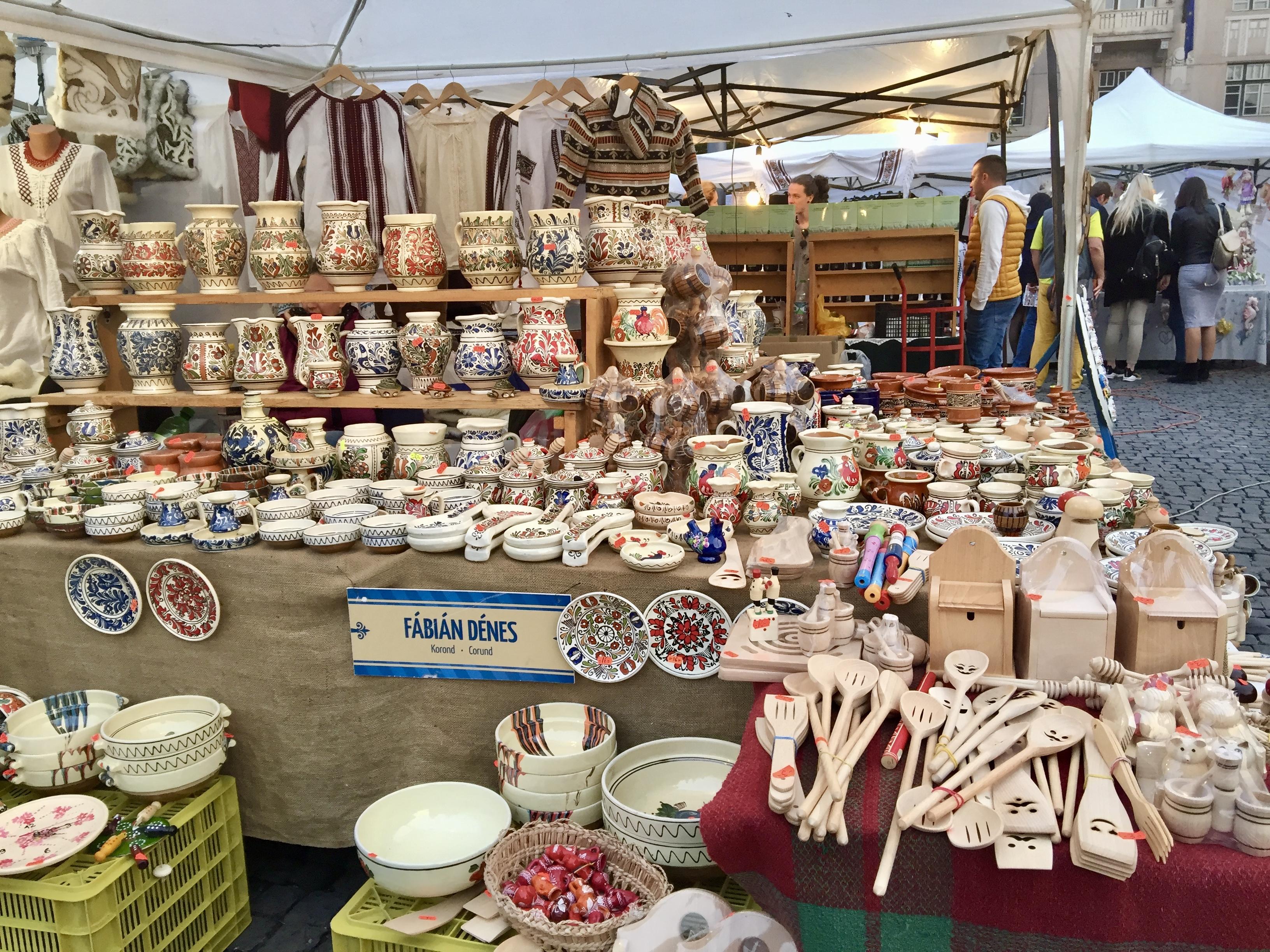
11. Traditional pottery items
Pottery holds a revered place in Romanian tradition, with its roots tracing back through our long history. In the countryside, the old traditional techniques for making pottery are passed from one generation to another, ensuring the preservation of the cultural heritage.
Horezu ceramics are a perfect example of this, and that’s why they’re recognised as a part of the UNESCO Intangible Cultural Heritage. They’re made only in a region 2h away from Bucharest or 1h away from Sibiu in the small town of Horezu but can be found in other parts of the country.
Another famous category is the black ceramics made only in the village of Marginea in the region of Bucovina.
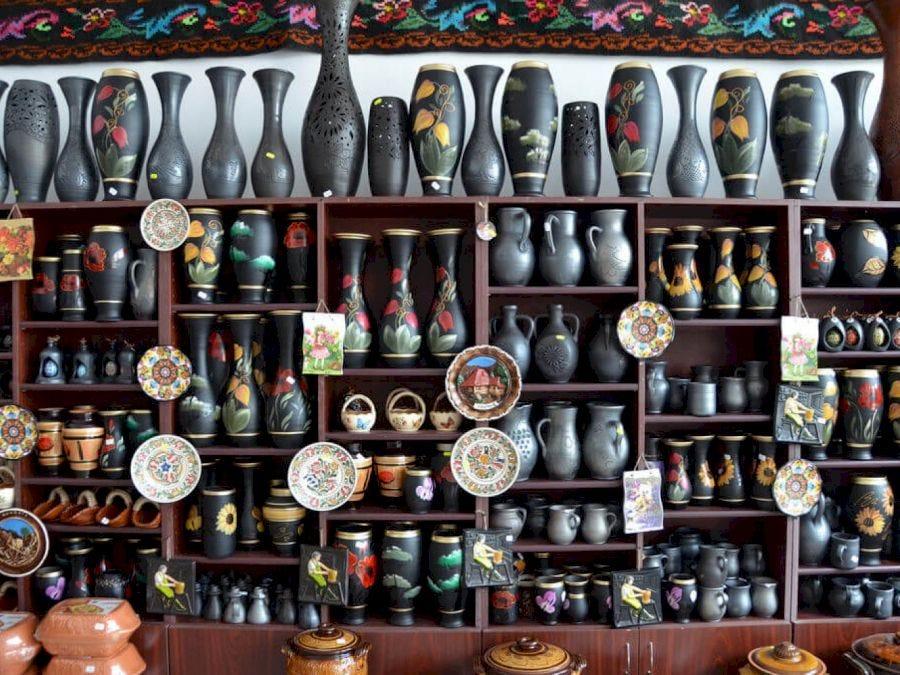
Dining from a vibrant, handcrafted ceramic plate is an experience that elevates the enjoyment of food to new heights. In fact, many traditional restaurants in Romania serve food in handmade ceramics, so you can note them and think if you like a particular type.
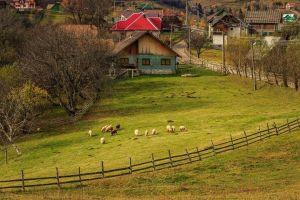
3-Day BEST of Transylvania Tour: Brasov, Sighisoara, Bran & Viscri
Start from: Bucharest
- Where to buy
Once again - traditional fairs are the best place to find these. Each region boasts its distinctive style and techniques, producing ceramics that reflect local culture and heritage.
You can also attend one of the internationally acclaimed Romanian pottery workshops led by local artisans. These take place in Marginea, Horezu, and Corund throughout the country, as well as in Săcel, Baia Mare, Vama, and Lăpuș in the Maramureș region of Northern Romania.
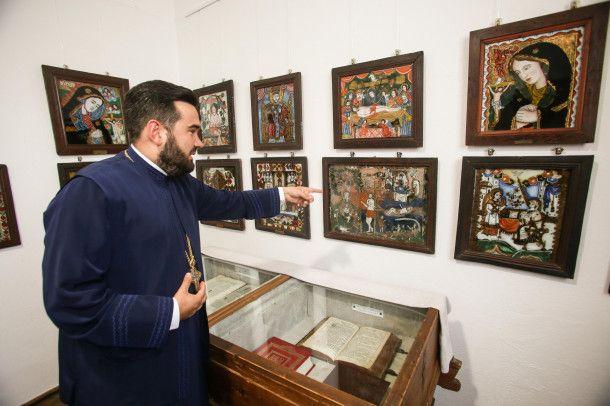
12. Glass-painted icons
Glass-painted icons represent a distinctive Romanian tradition, especially cherished in the region of Bucovina and its well-known Eastern Orthodox monasteries with colorful exterior frescoes. Moldavian princes were very fond of these forms of art.
You can see this tradition in various points of Romania too. For example, close to Sibiu, there is a Painted Glass Museum where you can find over 600 art pieces that reflect the spirituality of the Romanian nation.
Romanian museums that focus on our cultural heritage also typically have exhibitions where they showcase icons, including those painted on glass.
What sets this technique apart is the reverse painting method employed, where the intricate designs are meticulously crafted on the back of the glass, giving the finished piece a captivating luminosity and depth.
Known as painting in the mirror this method requires skill and precision, and the resulting icons often depict Orthodox religious themes and iconography. The icons refer to Orthodox iconography, but they can be painted by peasants, local masters, painters, or even children trying to learn this new technique.
Local tip:It's essential to handle and transport these delicate pieces with care to preserve their integrity and beauty!
- Where to buy
If you're going to Bucovina and want to dive deeper into this tradition, it's a great idea to join a local workshop that offers an immersive experience where participants can learn about the intricate techniques involved in creating such enduring treasures of spiritual value.
Afterwards, you have the option to take the glass-painted icon you created or to buy one created by a local artisan. You can also find them in souvenir shops of most Romanian churches or in the gift shops of certain museums.
13. Romanian cosmetics, skincare and naturopathy products
Romania is renowned for its abundance of natural remedies and skincare traditions, making it an ideal destination for those seeking authentic and effective skincare products.
From locally sourced ingredients to time-honored recipes passed down through generations, Romanian cosmetics such as creams, serums, and soaps offer a unique opportunity to experience the benefits of nature's bounty. They're often made purely from plants and natural ingredients.
Moreover, the Romanian cosmetics brands Gerovital and Aslavital have products based on the discoveries of Ana Aslan, the famous Romanian biologist and physician who published a lot of studies in the field.
As a user of these brands myself, I can attest to their exceptional quality and efficacy, making them a reliable choice for those seeking natural skincare solutions. I use several of them for skin treatments or when my back hurts :)
- Where to buy
Local markets are treasure troves of natural cosmetics that make perfect souvenirs. For those seeking a more curated selection of natural and organic products, Plafar shops provide a dedicated space where eco-conscious consumers can explore a wide range of skincare options aligned with their preference for natural ingredients.
Also, the brands Gerovital and Aslavital are available in supermarkets (and Plafars too).
14. Dracula souvenirs
Dracula, often regarded as Romania's best world ambassador, continues to captivate the imagination of visitors from around the world.
Inspired by the medieval prince Vlad the Impaler (also known as Vlad Dracula) and Bran Castle, the Dracula fictional character created by Bram Stoker and made famous by Hollywood movies created our country's #1 brand.
While we won't dive into the legend of Dracula, it's not hard to see why Dracula-related souvenirs are extremely popular among tourists.
So you may be forgiven if you think this is one of the most original Romanian souvenirs you can find - it's not. Except, perhaps, if they're about Vlad the Impaler.
So if you visit Bran Castle, the most famous castle in Romania, you'll find anything and everything related to vampires. From wood statues, paintings, shot glasses and plates, to pillows, magnets and stickers.
Local tip:Lots, if not all of these products, are low-quality and made in China. I know some of you will really want to bring home something typical of the land of Dracula - but just know we locals don't see this as a traditional Romanian souvenir
- Where to buy
The good news - ironically - is that you will find plenty of Dracula-themed souvenirs in almost any tourist spot or souvenir shop.
You'll find more 'variety' if you visit the tourist attractions associated with Vlad the Impaler: Bran Castle, Poenari Castle or Vlad Țepeș House in Sighișoara.
15. Hand-painted easter eggs
Romanians have many traditions for each celebration of the year, and we do have one for Easter too. It is a traditional practice originating from the centuries-old practice of Easter egg painting, but in this case, it takes on a colorful and intricate form, featuring vibrant floral or geometric patterns.
Local tip:These eggs are very fragile and you can easily break them on your way back home, so either pack them well or consider 'wooden' eggs if you want something more durable
Unlike the boiled and colored eggs commonly associated with Easter, these hand-painted eggs undergo a different process. Before painting, the eggs are carefully emptied of their contents through a small hole, allowing them to be preserved indefinitely. Each egg is then meticulously adorned with folk motifs and bright colors, transforming it into a cherished artifact in its own right.
- Where to buy
Undoubtedly these are the most unique souvenirs of the Bucovina region (part of which is included in Southern Ukraine) - this is where this tradition is 'at home'. If you're planning to visit, I highly recommend you learn some useful Romanian phrases as few locals speak English.
16. Mărțișoare (Spring trinkets)
Unlike other souvenirs on this list which can be found all year round, the Mărțișor is a unique Romanian souvenir available only at from the end of February to early March. These trinkets are used to celebrate Spring's arrival on 1 March and the rejuvenation of nature.
In Romanian society, this special occasion is dedicated to women. So men traditionally offer them Mărțișoare as tokens of appreciation and good luck charms. They come in many shapes, colors, and materials and can also range from very simple, mass-produced and cheap-looking, to very intricate, hand-made models and brooches.
These tokens are easily recognizable by the distinctive red-and-white string attached to them, symbolizing purity, energy, and the vibrant renewal of nature. They are worn by girls and Romanian women as a brooch or as a bracelet throughout Spring, one of the best times to visit Romania.
So consider getting a Mărțișor as a great souvenir for your beloved wife, girlfriend, mother, or any other special woman in your life.
- Where to buy
Days (or even weeks) before the beginning of March, the sidewalks and major squares in all Romanian cities will be full of stands selling mărțișoare. They're also available in shops with handmade products or supermarkets - so keep an eye out.
_ A pan flute is a great idea for a traditional Romanian souvenir_
17. Small musical instruments
If you're a music lover, Romania offers a variety of small musical instruments that make for memorable souvenirs - also fun to use.
Often handcrafted by local artisans, these instruments not only capture the essence of regional folk music but also resonate with the spirited rhythms of native dances performed across the country.
There are many traditional musical instruments in Romania used in native dances, so there's a wide variety of musicians too. Some of the most popular instruments are:
- kobza (cobză)
- cimbal (țambal)
- pipe (caval)
- fluier (flute)
- nai (pan flute).
The last two on this list are probably the most convenient in terms of size to be taken home as souvenirs.
And we have another great idea for you, especially for kids: ceramic bird whistles which are beautifully painted in vivid colors (like the feathers of a bird) and adorned with folk motifs.
- Where to buy
You can find small musical instruments available for purchase in various locations throughout the country: traditional markets, craft fairs and festivals, specialised music stores (in larger cities such as Bucharest, Cluj-Napoca, Brasov), traditional museums' gift shops, or street vendors in popular tourist areas.
***
I hope now have a better idea of what are the best Romanian souvenirs to buy.
After you read our guide on how to visit Romania - our locally made Romanian survival guide - and our list with the best things to do in Romania, you're all set for a great holiday.
And if you need help planning a wine tasting or want to attend a pottery workshop, let us know and we'll happily arrange that for you.
Your Romanian friend,
Iuliana
